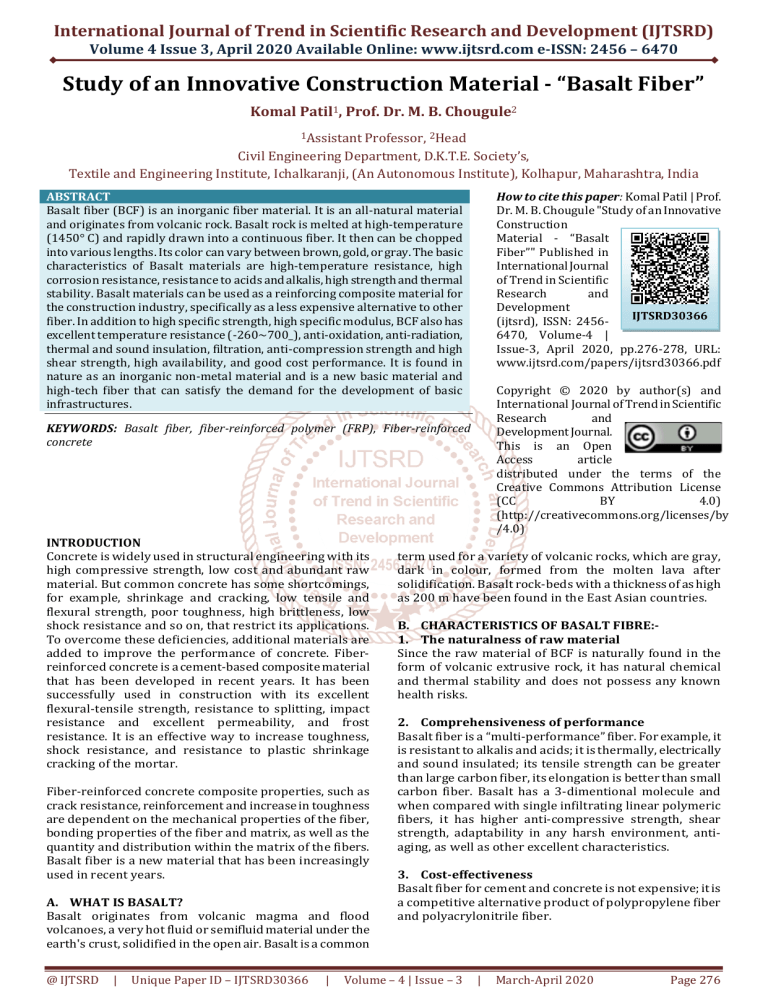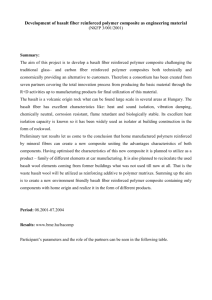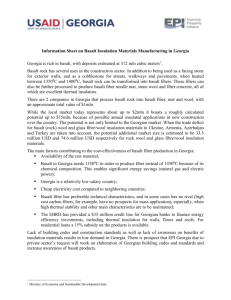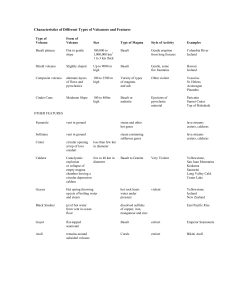
International Journal of Trend in Scientific Research and Development (IJTSRD) Volume 4 Issue 3, April 2020 Available Online: www.ijtsrd.com e-ISSN: 2456 – 6470 Study of an Innovative Construction Material - “Basalt Fiber” Komal Patil1, Prof. Dr. M. B. Chougule2 1Assistant Professor, 2Head Civil Engineering Department, D.K.T.E. Society’s, Textile and Engineering Institute, Ichalkaranji, (An Autonomous Institute), Kolhapur, Maharashtra, India ABSTRACT Basalt fiber (BCF) is an inorganic fiber material. It is an all-natural material and originates from volcanic rock. Basalt rock is melted at high-temperature (1450° C) and rapidly drawn into a continuous fiber. It then can be chopped into various lengths. Its color can vary between brown, gold, or gray. The basic characteristics of Basalt materials are high-temperature resistance, high corrosion resistance, resistance to acids and alkalis, high strength and thermal stability. Basalt materials can be used as a reinforcing composite material for the construction industry, specifically as a less expensive alternative to other fiber. In addition to high specific strength, high specific modulus, BCF also has excellent temperature resistance (-260~700_), anti-oxidation, anti-radiation, thermal and sound insulation, filtration, anti-compression strength and high shear strength, high availability, and good cost performance. It is found in nature as an inorganic non-metal material and is a new basic material and high-tech fiber that can satisfy the demand for the development of basic infrastructures. How to cite this paper: Komal Patil | Prof. Dr. M. B. Chougule "Study of an Innovative Construction Material - “Basalt Fiber”" Published in International Journal of Trend in Scientific Research and Development IJTSRD30366 (ijtsrd), ISSN: 24566470, Volume-4 | Issue-3, April 2020, pp.276-278, URL: www.ijtsrd.com/papers/ijtsrd30366.pdf Copyright © 2020 by author(s) and International Journal of Trend in Scientific Research and Development Journal. This is an Open Access article distributed under the terms of the Creative Commons Attribution License (CC BY 4.0) (http://creativecommons.org/licenses/by /4.0) KEYWORDS: Basalt fiber, fiber-reinforced polymer (FRP), Fiber-reinforced concrete INTRODUCTION Concrete is widely used in structural engineering with its high compressive strength, low cost and abundant raw material. But common concrete has some shortcomings, for example, shrinkage and cracking, low tensile and flexural strength, poor toughness, high brittleness, low shock resistance and so on, that restrict its applications. To overcome these deficiencies, additional materials are added to improve the performance of concrete. Fiberreinforced concrete is a cement-based composite material that has been developed in recent years. It has been successfully used in construction with its excellent flexural-tensile strength, resistance to splitting, impact resistance and excellent permeability, and frost resistance. It is an effective way to increase toughness, shock resistance, and resistance to plastic shrinkage cracking of the mortar. Fiber-reinforced concrete composite properties, such as crack resistance, reinforcement and increase in toughness are dependent on the mechanical properties of the fiber, bonding properties of the fiber and matrix, as well as the quantity and distribution within the matrix of the fibers. Basalt fiber is a new material that has been increasingly used in recent years. A. WHAT IS BASALT? Basalt originates from volcanic magma and flood volcanoes, a very hot fluid or semifluid material under the earth's crust, solidified in the open air. Basalt is a common @ IJTSRD | Unique Paper ID – IJTSRD30366 | term used for a variety of volcanic rocks, which are gray, dark in colour, formed from the molten lava after solidification. Basalt rock-beds with a thickness of as high as 200 m have been found in the East Asian countries. B. CHARACTERISTICS OF BASALT FIBRE:1. The naturalness of raw material Since the raw material of BCF is naturally found in the form of volcanic extrusive rock, it has natural chemical and thermal stability and does not possess any known health risks. 2. Comprehensiveness of performance Basalt fiber is a “multi-performance” fiber. For example, it is resistant to alkalis and acids; it is thermally, electrically and sound insulated; its tensile strength can be greater than large carbon fiber, its elongation is better than small carbon fiber. Basalt has a 3-dimentional molecule and when compared with single infiltrating linear polymeric fibers, it has higher anti-compressive strength, shear strength, adaptability in any harsh environment, antiaging, as well as other excellent characteristics. 3. Cost-effectiveness Basalt fiber for cement and concrete is not expensive; it is a competitive alternative product of polypropylene fiber and polyacrylonitrile fiber. Volume – 4 | Issue – 3 | March-April 2020 Page 276 International Journal of Trend in Scientific Research and Development (IJTSRD) @ www.ijtsrd.com eISSN: 2456-6470 4. Natural compatibility Basalt fiber is a typical ceramic fiber, it’s easy to disperse when mixed with cement concrete and mortar. Fresh basalt fiber reinforced concrete has good characteristics, such as volume stability, good workability, good stability, excellent thermal resistance, anti-seepage, crack resistance and impact resistance. Therefore, basalt fiber reinforced concrete serves the functions of reinforcement, crack resistance, and can extend the life of construction in the fields of housing, bridges, highways, railways, urban elevated roads, runways, ports, subway tunnels, the coastal protection works, plant facilities. BCF is natural material and will bring revolutionary changes in construction and transportation. C. MANUFACTURING PROCESS OF BASALT FIBER:A scheme presentation of the manufacturing process High elastic modulus provides specific tenacity exceeding steel fiber by many times. Very high-temperature tolerance- maintains integrity at sustained temperatures upto 982 C Low friction coefficient. Will not split longitudinally. 2. BASALT FIBER FELT MAT: Filament diameter 13 microns. Able to withstand temperatures up to 982C Versatile way to protect structural steel from fire and heat devastation. Industrial and domestic furnaces High sound absorption for noise abatement. Refrigeration insulation. Very alkali and acid resistance. Negligible moisture absorption Remarkable immunity to nuclear radiation, UV light and biologic contamination. 3. BASALT FIBER RODS: Basalt rocks are crushed in 5~20 mm fraction→ Crushed raw material transported into the furnace melting (2) by loader (1) → Inside the furnace basalt is melted at 1400 - 1600 → Basalt passes through a platinum alloy set - holes of bushing (3) → Continues filament formation with diameter 9~15 microns (4) is lubricated through the lubricator (5) and reeling up by the winding machine (6) on bobbins (7) → Rewinding of primary string by machine (8) from bobbins (7) on roving spool (9) D. TYPES OF BASALT APPLICATIONS:1. BASALT FIBER ROVING: FIBRE & THEIR Higher specific strength than steel rebar. 89% lighter in weight, 1 ton of basalt reinforcement rods provides the reinforcement of 9.6 tons of steel rebar. Resistance to corrosion and deterioration of natural elements. Ideally used for hydraulic engineering highway reinforcement. Concrete building and facing slab. Alternative construction solution in regions prone to earthquake and seismic hazards. 4. BASALT FIBER FABRICS : Filament diameter- 9~23microns. Good tensile strength. Low elongation under load. Inert, corrosion –resistance & non toxic. Very high resistance to chemical alkaline acids and solvents. @ IJTSRD | Unique Paper ID – IJTSRD30366 | Good adhesion characteristics for coatings. Resistance to electromagnetic radiations. Noncombustible and fire-resistant. Volume – 4 | Issue – 3 | March-April 2020 Page 277 International Journal of Trend in Scientific Research and Development (IJTSRD) @ www.ijtsrd.com eISSN: 2456-6470 E. APPLICATIONS OF BASALT FIBRES IN CIVIL CONSTRUCTION: Building constructional and facing plastics; reinforcing plaster grids; warmed panels for construction of prefabricated houses, floors, dropped ceilings, fireproof walls, fire-resistant doors, building plastics. Basalt plastic reinforcement for bridges, tunnels, railway sleepers, metro, construction materials. Reinforcement for asphalt concrete coverings of roads, runways of airports. Waterproof rolled and sheet materials, roofing materials. Hydraulic engineering construction, including reinforcing materials for construction of dams, irrigation materials. Fireproof Materials:-Used in construction of high rise building & main industrial construction project. partitioning of the buildings, elevator shafts, and in sound insulators. Port construction, sea platforms, Reinforcing and constructional materials made from basalt plastics; paint & varnish proof coverings of bridges & tunnels; main construction projects; waterproof coverings for ferroconcrete installations; nonflammable and heat resistant paints & varnish coverings. CONCLUSION: Basalt fibers have the advantage of low weight compared to the steel and also have a similar coefficient of thermal expansion as that of concrete. On weight basis, one kilogram of basalt reinforcement can replace 9.6 kg of steel in the concrete structure. The rebar’s made from basalt fiber is a viable alternative to the conventional steel reinforcement, as it is found to be superior in many aspects. When moderate structural strengthening but high resistance for fire is simultaneously sought for building structures, the basalt fiber strengthening will be a good alternative methodology among other fiber-reinforced polymer (FRP) strengthening systems. REFERENCES [1] Redon, C.; Li, V.C.; Wu, C.; Hishior, H.; Saito, T.; Ogawa, A. Measuring and modifying interface properties of PVA fibers in ECC matrix. J. Mater. Civil Eng. 2001, 13, 399–406. [2] Dias, D. P.; Thaumaturgo, C. Fracture toughness of geopolymeric concretes reinforced with basalt fibers. Cem. Concr. Compos. 2005, 27, 49–54. [3] Sim, J.; Park, C.; Moon, D. Y. Characteristics of basalt fiber as a strengthening material for concrete structures. Compos. Part B Eng. 2005, 26, 504–512. [4] Ramakrishnan, V., & Panchalan, R. (2005). A new construction Material—Non-corrosive basalt bar reinforced concrete. Special Publication, 229, 253-270. [5] Kamenny Vek. (2009). Advanced basalt fiber. Basfiber. Retrieved May 9, 2012, from http://www.basfiber.com/ [6] Jón Ólafur Erlendsson (2012). Continuous Basalt Fiber as Reinforcement, Material in Polyester Resin. MSc thesis. Reykjavik University. [7] Borhan, T. M. 2012. “Properties of glass concrete reinforced with short basalt fiber”. Mater Des 42:265– 71 [8] Cech, V., Palesch, E. and Lukes, J. 2013, “The glass fiber– polymer matrix interface/interphase characterized by nanoscale imaging techniques”, Basalt filaments incorporated unidirectional rods are used as the reinforcement of concrete slabs in hydraulic engineering and construction in seismically hazardous regions. It can also be used in the interiors, @ IJTSRD | Unique Paper ID – IJTSRD30366 | [9] Gauvin, F., Cousin, P. and Robert, M. 2015, “Improvement of the Interphase Between Basalt Fibers and Vinylester by Nano-Reinforced Post-Sizing” [10] Naaman, A. E. Fiber reinforcement for concrete. Concr. Int. Des. Constr. 1985, 7, 21–25. Volume – 4 | Issue – 3 | March-April 2020 Page 278





